Write the Following Inequality in Slope Intercept Form -12x-2y>= -42
Examples of Graphing Linear Inequalities
Now we are ready to apply the suggested steps in graphing linear inequality from the previous lesson. Let's go over four (4) examples covering the different types of inequality symbols.
Example 1: Graph the linear inequality y>2x-1.
The first thing is to make sure that variable y is by itself on the left side of the inequality symbol, which is the case in this problem. Next is to graph the boundary line by momentarily changing the inequality symbol to equality symbol.

Graph the line y>2x-1 in the xy axis using your preferred method. Since the inequality symbol is just greater than ">" , and not greater than or equal to "≥", the boundary line is dotted or dashed. So here's how it should look so far.
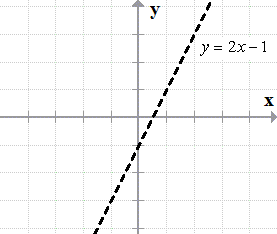
The last step is to shade either above or below the boundary line. From the suggested steps, we were told to shade the top side of the boundary line if we have the inequality symbols > (greater than) or ≥ (greater than or equal to). Always remember that "greater than" implies "top".
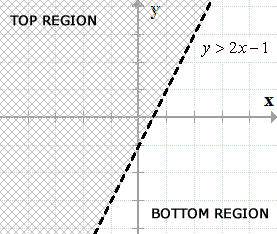
To check if your final graph of the inequality is correct, we can pick any points in the shaded region. For this, let's have the point (−1, 1).
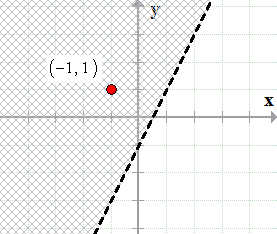
Evaluate the x and y values of the point into the inequality, and see if the statement is true. In the point (−1,1), the values are x=-1 and y=1.
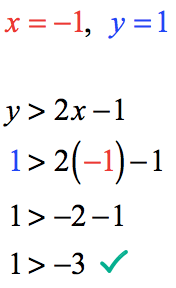
Since the test point from the shaded region yields a true statement after checking with the original inequality, this shows that our final graph is correct!
Example 2: Graph the linear inequality y \ge -x+2.
The variable y is found on the left side. That's good! Notice, we have a "greater than or equal to" symbol. The "equal" aspect of the symbol tells us that the boundary line will be solid. So let's graph the line y=-x+2 in the Cartesian plane.
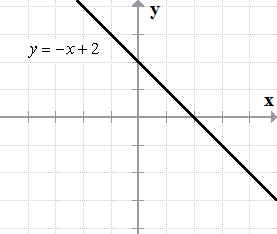
Just like in example 1, we will shade the top portion of the boundary line because we have a "greater than" case.

Verify if our graph is correct by picking the point (4,2) in the shaded section, and evaluate the values of x and y of the point in the given linear inequality.
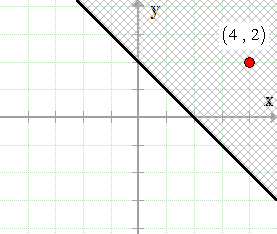
From selected test point, x=4 and y=2
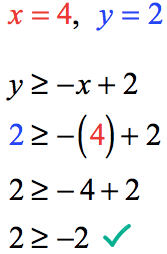
We have a true statement which makes us confident that our final graph of the inequality is correct as well.
Example 3: Graph the solution to the linear inequality \large{y < {1 \over 2}x - 1} .
Looking at the problem, the inequality symbol is "less than", and not "less than or equal to". Because of this, the graph of the boundary line will be broken or dashed. In addition, "less than" means we will shade the region below the line. That's all there's to it!
Here's the graph of the boundary line \large{y = {1 \over 2}x - 1} .
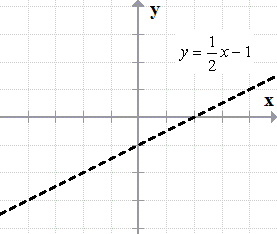
Since the inequality symbol is less than (< ), we shade the region below the dashed line.
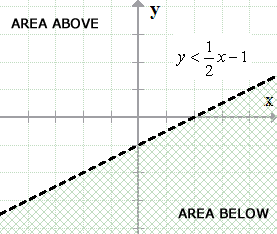
I will leave it to you to verify that this is the correct graph by picking any test points from the shaded area and check them against the original linear equality.
Example 4: Graph the solution to the linear inequality y \le - {2 \over 3}x + 2 .
Since we have gone over a few examples already, I believe that you can almost work this out in your head. You can impress your teacher by giving a short solution just like this.
I see that the inequality symbol is "less than or equal to" ( ≤ ) which makes the boundary line solid. More so, the solution is below the boundary line because of the "less than" aspect of it. Here's the correct graph of the inequality.
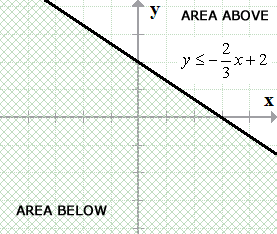
In the examples above, you have seen linear inequalities where the y-variables are always found on the left side. You may even think of them as linear inequalities in slope-intercept form of a line.
X and Y are on the same side of the inequality symbol
This time, we are interested in examples where the x and y variables are located on the same side of the inequality symbol.
We may call them as linear inequalities in Standard Form. The following are four general cases where A, B, and C are just numbers or constants.
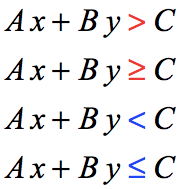
What we need to do is to rewrite or manipulate the given inequality such that the variable y is forced to stay on the left side. In other words, we are going to solve for y in terms of x. After doing so, we can now apply the suggested steps in graphing linear inequality as usual.
Let's go over some examples.
Example 5: Graph the linear inequality in standard form 4x + 2y < 8.
Start solving for y in the inequality by keeping the y-variable on the left, while the rest of the stuff are moved to the right side. Do that by subtracting both sides by 4x, and dividing through the entire inequality by the coefficient of y which is 4. Since we divide by a positive number, the direction of the inequality symbol remains the same.
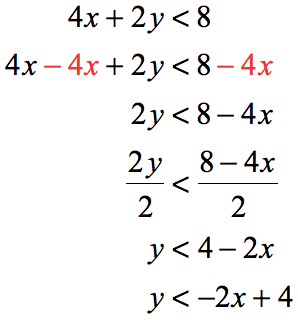
Since we have a "less than" symbol (<) and not "less than or equal to" symbol (≤), the boundary line is going to be dotted or dashed.
Just in case you forgot where to get the boundary line, change the inequality to equality symbol for the time being, that is, from y<-2x+4 to y=-2x+4. Then graph the equation of the line using any of these methods.
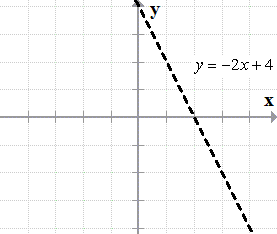
So the next obvious step is to decide which area to shade. Would it be above or below the boundary line? We will shade the bottom region of the boundary line because we have a "less than" case after we transformed the original inequality problem into the form in which is the y is on the left side.

We can verify if we have graphed it correctly by choosing any test points found in the shaded region. The best test point is the origin which is the point (0,0) because it is easy to calculate.
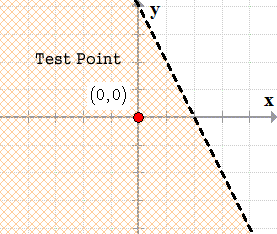
The test point (0,0) means x=0 and y=0. Evaluate these values in the transformed inequality or the original inequality to see if you get a true statement.
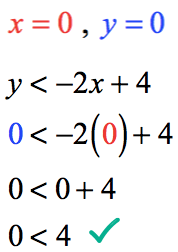
It does work! So we have shaded the correct region which is below the dashed line.
Example 6: Graph the linear inequality in standard form 3x - 6y \le 12.
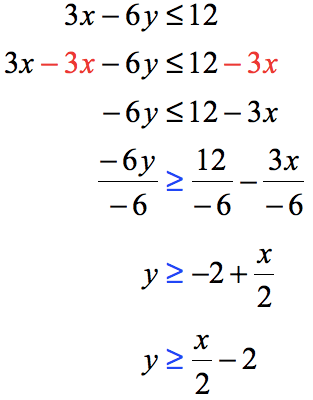
To keep the variable y on the left side, I would subtract both sides by 3 x and then divide the entire inequality by the coefficient of y which is − 6.
REMEMBER: When dividing the inequality by a negative number, we must change or switch the direction of the inequality symbol.
The "new" inequality will have a solid boundary line due to the symbol "≥" where it has the "equal " component to it. In addition, since y is "greater than" that means I will shade the region above the line.
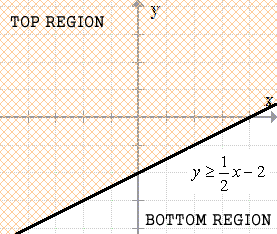
You might also be interested in:
Solving Linear Inequalities
Steps on How to Graph Linear Inequalities
Graphing Systems of Linear Inequalities
Solving Compound Inequalities
Write the Following Inequality in Slope Intercept Form -12x-2y>= -42
Source: https://www.chilimath.com/lessons/intermediate-algebra/graphing-linear-inequalities-examples/
0 Response to "Write the Following Inequality in Slope Intercept Form -12x-2y>= -42"
Post a Comment